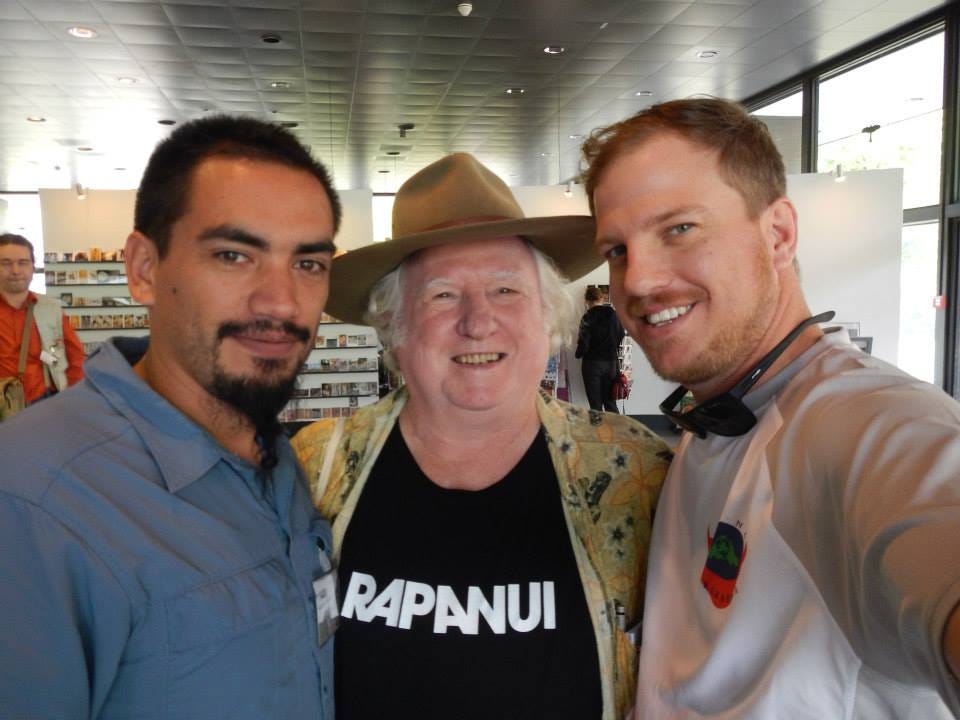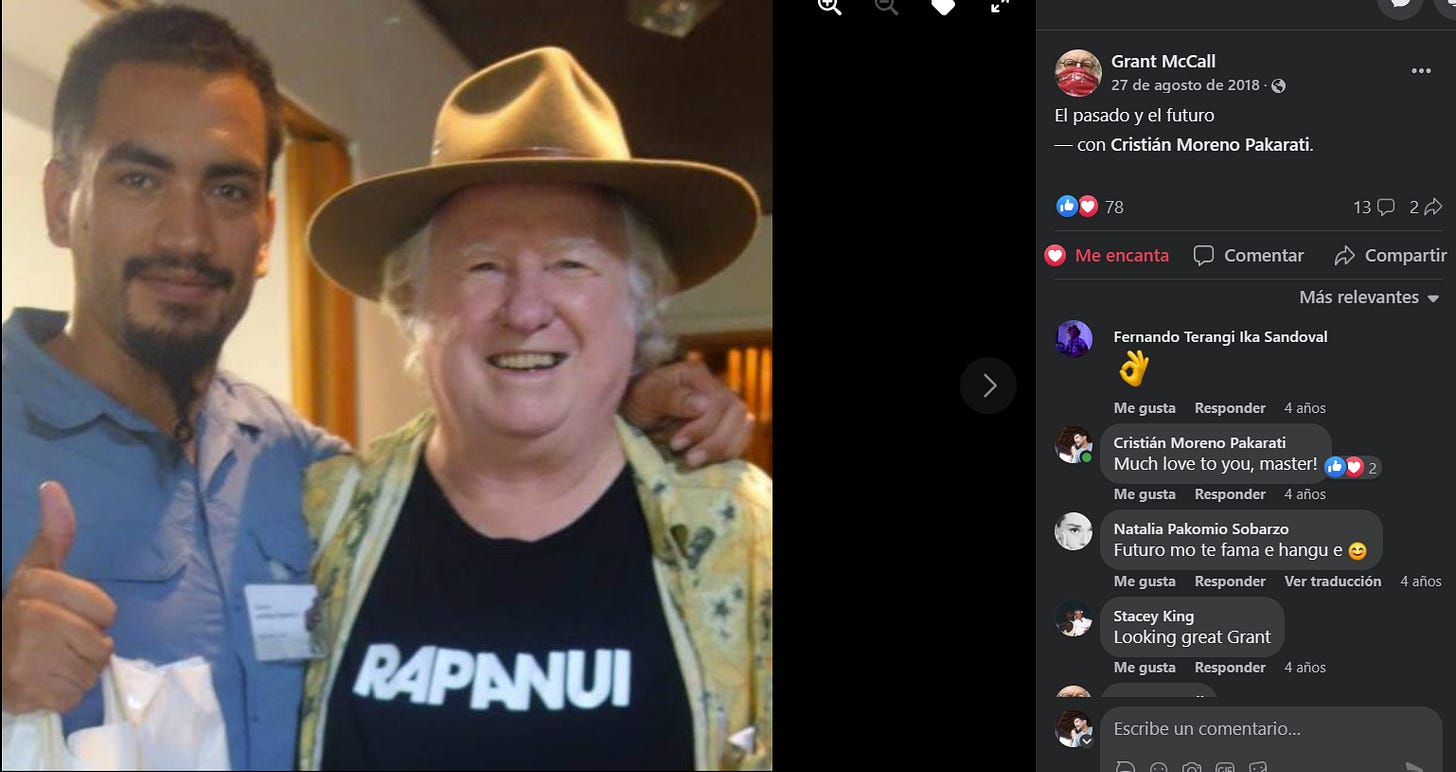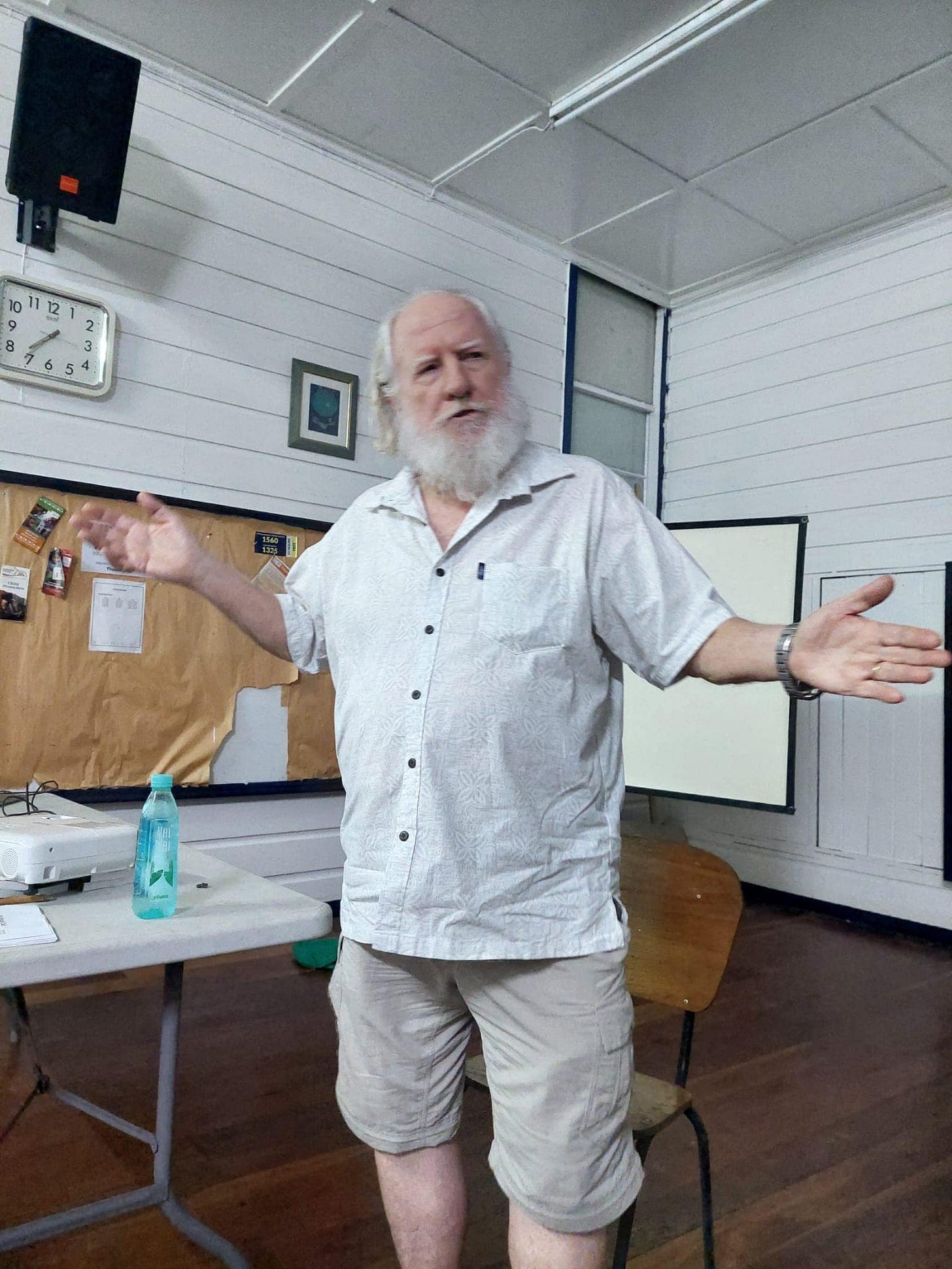In Memoriam: Grant Edwin McCall (1943-2023)
Remembering the late and great Australian anthropologist and his lifetime work dedicated to Rapa Nui and the Pacific Islands.
For a young researcher, as I was in the decade of 2000, with a strong interest in genealogical and photographic topics related to Rapa Nui, the figure of Grant McCall was an almost legendary presence. His work, beginning in the 1970s, produced seminal works such as his doctoral thesis Reaction to Disaster: Continuity and Change in Rapanui Social Organisation (1976), a historical article in the Journal of the Pacific Society (JPS) titled “European Impact on Easter Island: Response, Recruitment and the Polynesian Experience in Peru” (1976), and a philosophical essay about Angata’s Revolt titled “Thirty-seven Days that Shook the (Rapanui) World: Angata’s Cult on Easter Island” (1992) which was based on a presentation at a Pacific History Association conference.
Each one of them was a pioneering work in its own right. The thesis was the first comprehensive attempt to outline contemporary Rapanui society in light of its dramatic history. The JPS article was replicated and expanded upon by authors such as Jesús Conte Oliveros and Milton Godoy Orellana. The Angata publication served as the foundation for Nelson Castro Flores' book on the topic and enabled further exploration of the movement by Rolf Foerster and, notably, my own work.

During my college years, I began accumulating a substantial database of documents, place names, old photographs, and family trees. Naturally, I started with the information presented in the genealogical book published by the Council of Rapanui Chiefs, titled, Te Mau Hatu ‘o Rapa Nui: Los Soberanos de Rapa Nui, pasado, presente y futuro (1988). However, McCall’s genealogical work notes, available at the William Mulloy Library (Las Fundaciones de Rapa Nui, from 1981), revealed significant differences that I incorporated, along with several other sources, into my own extensively expanded family tree of the Rapanui people—now boasting almost 6000 individuals.
In 2007, I made the decision to establish contact with Grant in order to obtain specific information and general guidance on how to approach the subjects that intrigued me the most. I sent him an email and then waited. And waited. And waited. I diligently checked my inbox every day, yet there was no response. It was likely a couple of months later when I finally received a courteous but encouraging reply. He apologized for the delayed response while assuring me that it was because he wanted to provide a 'well-thought-out' answer. Not only did he furnish me with the information I sought, but he also offered invaluable advice to help me further explore the directions I had contemplated. This initial interaction left me with the impression that he took pleasure in witnessing a new generation of scholars (and particularly a Rapanui researcher) delving into the same subjects he had explored decades earlier. He seemed conscious of his role in sparking that interest. This impression was consistently reinforced by all our subsequent interactions.
I finally had the opportunity to meet him in person in 2012 in Santa Rosa, California, during the Eighth International Conference on Easter Island and the Pacific, held at the Hyatt Vineyard Creek hotel and organized by the Easter Island Foundation (EIF). Contrary to the mythical image of an archival research powerhouse and a strict ethnologist in the field, Grant McCall proved to be pleasantly affable, entertaining, and a speaker of wit and keen insight. During the welcome dinner, he regaled us with his surreal experience in the 1970s involving the Major of Carabineros in Rapa Nui, an bizarre character named Omar Fuenzalida Tobar. His storytelling was prime stand-up comedy, leaving the entire audience doubled over in laughter and wiping tears from their eyes.
Throughout the ensuing days, our discussions spanned a wide range of Rapanui topics, often extending into the late hours of the night as we shared beers with fellow academics. He especially relished the company of the few other Rapanui attendees present at the conference. Following the conclusion of the event, we maintained contact through email, even though he had retired from active research.
I encountered him once again in 2015 at the Ninth Conference organized by the EIF, this time in collaboration with the German Archaeological Institute, which took place at the Dahlem Ethnological Museum. During coffee breaks, his table was swiftly surrounded by individuals eager to hear about his academic endeavors and island escapades. At that time, there was a contentious hypothesis circulating regarding the Polynesian Rat's role as a pivotal agent in Rapa Nui's deforestation—a notion widely propagated by the media. Grant, in his characteristic manner, would wryly pose the question to anyone he crossed paths with: 'And what about the rats?' If there were no inquiries following a lecture, regardless of whether the topic centered on the Rongorongo script or paleoecology, he would interject with a grin: 'What about the rats?' This quip elicited hearty laughter from all attendees and became the conference's unofficial catchphrase.
In 2018, seemingly out of nowhere, Grant shared a photo of the two of us on his Facebook timeline. Accompanying the image was the Spanish caption “El pasado y el futuro” (“The past and the future”), a clear reference to his retired status as a researcher and the initial stages of my work, closely linked to his. I replied only with a “much love to you, master”. It took some time until it sank in as some sort of passing of the torch. It’s no longer Grant McCall’s lonely field, rather, it's now being carried forward by perhaps a couple of dozen scholars who are building upon his enduring legacy.
Grant used to recount a phrase that some older Rapanui individuals directed at him when they observed him asking questions, conducting interviews, and gathering information about the island's society. Recognizing that many earlier researchers on Rapa Nui had achieved considerable renown in the fields of archaeology and anthropology, and discerning Grant's own intentions, told him in an encouraging way: “Mo te fama, e hangu e!” (“For fame, oh, young’n”). With a touch of sarcasm, he later adopted and used this phrase to motivate others in a similar manner. These words became prophetic as Grant left us as a true legend, well regarded in the Pacific, North and South America and Europe.
Mo te fama, e hangu e, indeed.
RIP.





